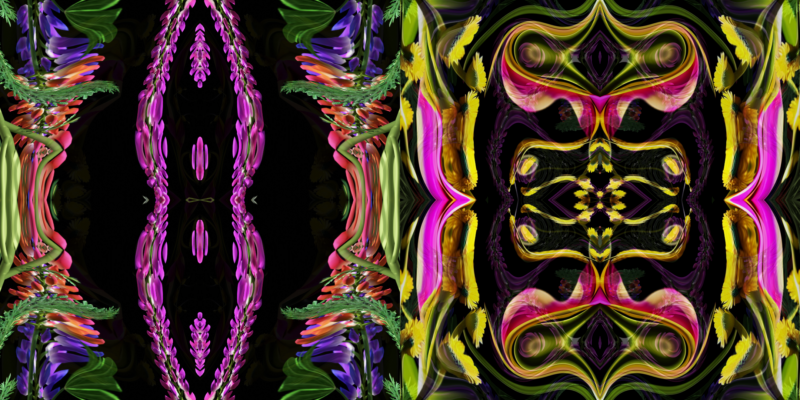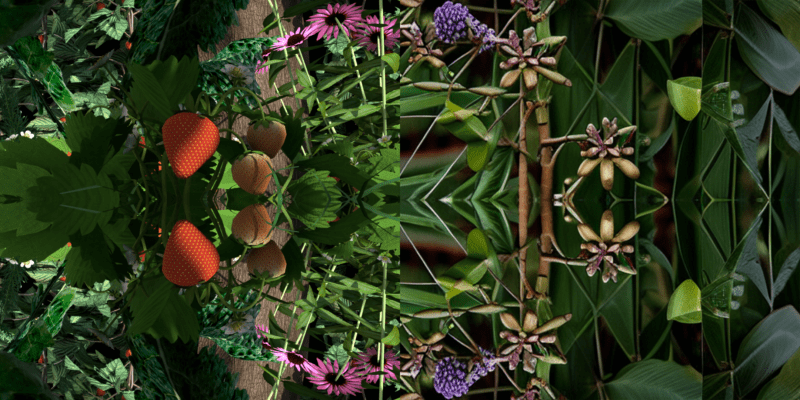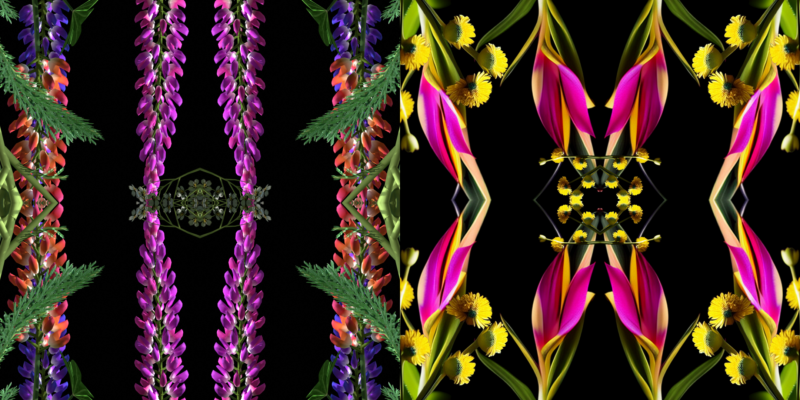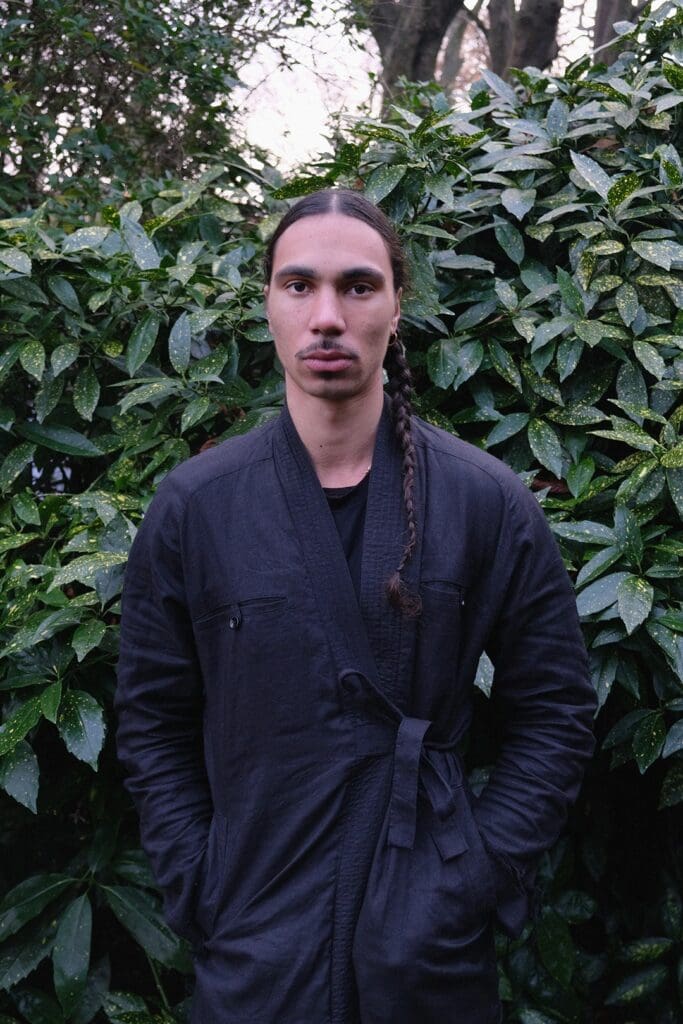NEUROMANCER. A Space Odyssey. Colossus: The Forbin Project. The Matrix. Ex Machina. We have countless cultural examples of AI gone rogue – Orwellian dystopian worlds where artificial intelligence betrays the society that birthed it, leaving a trail of destruction in its wake.
Think futuristic cyberpunk metropolises with chaotic streets and the contrast turned all the way up. But some artists are uprooting this apocalyptic vision and planting a new one – what if we imagine a future where AI is not the cause of our decimation, but our saviour?
This question led multimedia artist, Carola Dixon, and musician, Dominique Dahlström, to the sweltering centre of Dubai for COP28. There, they exhibited their mind-bending audio-visual piece, GaiA.
A swirling tapestry of stalks, stems and stamens, the duo’s glowing garden universe folds in on itself to celebrate the beguiling essence of the natural world. Using Blender, the self-taught Dixon animated a garden of wild strawberries and water droplets merging into one another – a tessellated ode to life-sustaining patterns that are as old as the earth itself.

GaiA in Process
This digital dreamscape wouldn’t be complete without Dahlström’s ethereal soundtrack. Folding nature recordings in with AI-generated melodies, his spacey blips lull the audience into a meditation on the future. The track is about to be released, so you can drop into GaiA’s wavy world wherever you find yourself.
But there’s a third contributor to this wonderland. After showing the meditation to audiences at COP, the pair asked attendees, ‘What plants will you grow in cyberspace?’ Based on their answers, AI created an evolving tapestry of images that weaves new threads into the solarpunk garden of delights.
Working with stable diffusion, Dixon downloaded different models trained on various datasets and manually updated the piece. The final version of GaiA will be shown at London’s Garden Museum at the end of February.

Carola Dixon
As we face the climate crisis, the duo believe that evolution of new forms of intelligence can guide our species into an ecocentric future, “We want people to see that AI has a huge amount of power and it can really help us reconnect ourselves to the natural world.”
At its core then, the work is a utopian collaboration between mankind and machine. The partnership sounds simple enough – the AI receives inputs, generates various images, and Dixon incorporates them into the work – but it has unearthed a web of nuances that reveal our biases just as much as our hopes for new beginnings.

GaiA
For one, working with AI has proved to Dixon that machine imitates the man – our cultural prejudices are embedded within artificial intelligence. After hearing an Indigenous person speak about tobacco during COP, Dixon was curious to see how the AI would respond when she inputted, ‘tobacco’.
The results were jarring, “All of the images were coming from tobacco plantations and they were really brightly lit. It’s seen in these sterile environments because it’s been massively commodified and associated with smoking. However, this perception is not universal. Someone who lives in places where the plant grows wild may see it as a shelter for animals, or recognise it for its spiritual and healing properties.”
It was an eye-opening moment for the artist because it reinforced that there’s a massive bias instilled in artificial intelligence, especially when it comes to the natural world.
As a species, we seem to draw a distinction between plants that are perceived as products to be bought and rare lifeforms to be appreciated, “There are some plants we revere… such as a wild orchid or a very old tree…We aestheticise them and think, ‘This is the wild. This is nature.’” Like mother, like daughter, AI has followed our lead, mirroring artificial boundaries deeming some plants ‘wild’ and others ‘for sale’.

GaiA
But make no mistake, AI is not the antagonist here. Dixon sees it less as death destroyer of worlds, more nascent life form – it’s our child and we are raising it. Whenever we work with AI, it marks “an opportunity for us to reflect on our own values.”
There’s power in that because mankind also has the ability to broaden the perspectives that contribute to these systems. A world where we’re more reliant on AI generated images is inevitable.
As we navigate that shift in real time, Dixon believes “it’s our role to actively challenge and teach the AI to widen its focus… When we look at preserving biodiversity, it’s so important to ensure that we’re broadening conceptions of what the plant kingdom is so we don’t end up in this monoculture.”

Dominique Dahlstrom
So it seems the problem and the power lies with us. Even so, Dixon doesn’t want to be seen as someone who blindly ignores the risks of AI or chooses wilful ignorance. Rather, her view stems from the core belief that “AI will be whatever we tell it it is… If we only tell it that it’s dangerous, if every conversation is only about how it will lead us to this dystopian future, then we will inevitably end up there because AI is literally trained on the data we put into the world.”
Instead, she wants to show us how technology can reconnect us with each other and the natural world. Dixon laughs as she tells me how audiences in Dubai input the same plants, over and over again. There were plenty of people from the Global South in attendance, so coconut kept cropping up, “I think there’s something really beautiful about seeing that 20 other people have said they love the same thing as you. We can find our shared values within that.”
GaiA offers us a fresh visual universe, but it’s more than an aesthetic digital garden – the piece is an examination of who we are and where we are going. Amid the futuristic dreaming, Dixon and Dahlström’s message is clear. AI is not a herald of the end of days – it’s a vehicle for us to explore our shared humanity in the global effort to solve the climate crisis.
“To me, as an artist, I feel like I have almost a moral duty to create art that proposes a positive version of the future using technology. What people see and what people can imagine is what becomes reality. Right now, there’s this imbalance where many people only see and imagine dystopia. We need to be able to see how AI can be a force for good.”
After watching the paradise that is GaiA, you might just start believing a better future into reality too.
by Christiana Alexakis
